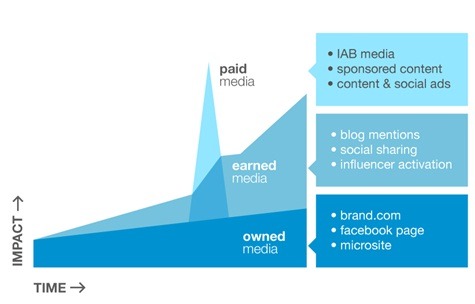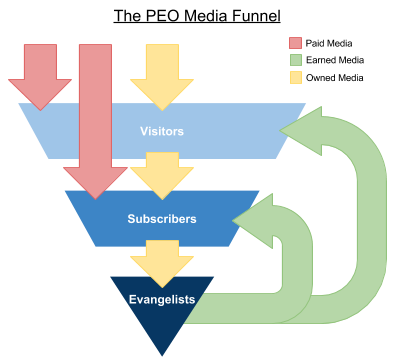Content originally written by Jonathan Strauss and published on the awe.sm blog
Greg Shove, CEO of Halogen Media, had a great post yesterday on the paid, earned, owned (PEO) media model. This framework for integrated marketing campaigns isn’t new: I saw it mentioned on Darren Herman’s blog recently; Fred Wilson was the first I noticed applying the earned media term to social media back in 2009 (part 1, part 2); and in a former life in electoral politics, I was first introduced to “earned media” (then applied purely to press coverage) way back in 2003.
Greg does a great job of discussing how a large brand can apply this integrated model by reallocating their substantial marketing budgets in ways that take better advantage of the amplification effect of earned media (see below chart from his post). And we’re actually working with Halogen right now to comprehensively measure the impact of the various components of an integrated PEO media campaign they’re planning for one of their brand-name clients. But what about everyone else?
The PEO media model for the rest of us
What got big brands looking at social media to begin with were the early examples of exceptional success by independent marketers — Fred’s original earned media post was about @kogibbq, hardly a big brand. And what originally inspired us to tackle performance marketing for social media was its efficiency (what we call the word-of-mouth superconductor). We believe this efficiency is potentially even more disruptive than SEM in democratizing online marketing, because — at its best — social media enables small marketers to reach the right audience with the right message in the right way at minimal costs.
So, how does a smaller business that may not even have a robust website, let alone a microsite or a display advertising budget, take advantage of the potential power of the PEO media model? First, you have to redefine what each of the terms mean (in order of importance for smaller businesses):
- Owned Media: There are 3 basic components of your owned media presence: blogging; email; and social media. The blog should be the center of your online universe — email and social media are essential in syndicating your content to wherever your audience lives and interacting with them when they engage with your brand there, but you always want the source of the content to be on the site you control. And you should be trying to turn every new visitor to your blog into a subscriber (and ultimately an evangelist) with a prominent Twitter Follow Button, Facebook Like Box, and email subscribe form.
- Earned Media: This is basically how the ‘evangelist’ segment of your audience is sharing your message with their friends, and it’s the levelest part of the playing field because earned social media basically works the same regardless of the size of your brand or your budget. And the smaller your audience, the more intimate (and thus stronger) your relationships with your evangelists can be — they are helping their friends discover something new that they love, capitalize on their passion. The basic value of syndicating your content to Twitter and Facebook is not so people can see it (because of the real-time Twitter stream and automatic Facebook newsfeed optimization, an email or RSS subscriber is much more likely to see a given piece of new content than a Twitter follower or Facebook fan), it’s so the people who do see it there engage with and share it in those contexts (i.e. reply/retweet on Twitter and comment/like on Facebook). You also want to give every site visitor the opportunity to be an evangelist by adding appropriate sharing calls-to-action to your blog.
- Paid Media: For a lot of smaller marketers, this isn’t necessarily a must-have as long as you’re creative with your audience-building efforts through owned and earned media. Some relatively straightforward examples include: exclusive deals for Facebook fans; one-off contests and promotions to drive your existing audience to turn their friends into fans and followers; and adding more systematic recognition and rewards for your most effective evangelists (aka gamification). If you are going to buy ads, use Facebook’s engagement ad formats and experiment with their robust targeting to get the most bang for your buck. But keep in mind it’s not the quantity of fans that counts the most here, it’s the quality of fans you acquire. So don’t just optimize for acquiring the cheapest fans, try to figure out ways to quantify the LTV of the fans you acquire in terms of the effectiveness of their evangelism rather than just their own engagement.
Optimizing your PEO media funnel
As a smaller marketer, it’s all about performance — you can’t afford to waste your precious time and possibly money on anything that doesn’t have a positive ROI. I always find the best way to think about performance as a funnel, so let’s use the following funnel analogy to talk about the PEO media model in performance terms. You fill the top of your funnel with Visitors through interesting content on your blog (owned media), which helps with SEO, and is possibly augmented with some very targeted paid search (paid media). Your site is designed with clear calls-to-action and possibly incentives to become Subscribers in the form of Twitter followers, Facebook fans, and/or email subscribers (owned media), and you can potentially directly acquire Twitter followers and/or Facebook fans with ads (paid media). You activate those Subscribers to become Evangelists by syndicating your content to the places they share and through community management (owned media). And those Evangelists start helping you fill the funnel with new Visitors and Subscribers as they share your content and brand with their friends (earned media).
The key to all of this is obviously the earned media component. As Greg says in his post:
“Earned media isn’t new, but nowadays it’s scalable, sustainable, and influential. Maintaining this earned media presence requires budget allocation, but it’s more ‘management’ than buying: creating an editorial calendar, monitoring the conversation starters, and consistent measurement (over months, not days).”
If I can get 1,000 evangelists to share my message with the right 10 of their friends, that is the most effective way possible for me to reach those 10,000 people. The key for a smaller marketer is making sure it’s also an efficient way to do so. And that takes data.
As Greg says at the end of that quote, the PEO media model is a marathon not a sprint. It’s about ongoing optimization of chronic marketing efforts, not trying to maximize the impact of a single acute campaign. The narrative nature of the human mind means we love looking for that one tweet by an influencer that gets 100 retweets and 1,000 clicks, but the reality is much less glamorous — success is built from a broad base of passionate evangelists who are likely only influential with their core network. So, the challenge ends up being more like how do you go from an ongoing average of 10 clicks per tweet by 100 evangelists to an average of 12 clicks per tweet by 150 evangelists rather than how do you get someone with 10,000 followers to tweet your link once.
The most valuable ways we see performance-focused marketers using data to optimize their efforts within the PEO media model are:
- Optimizing your owned media: When it comes to producing and syndicating content on a regular basis, what your sharing, with whom you’re sharing it, and when you share it all combine to play a role in how it’s received and ultimately the results it drives. Only over time and repeated attempts will you be able to start seeing the patterns in the data that can distinguish the impact of each of those factors (think multi-variate testing). And because your fan and follower counts change over time (hopefully up :D ), we offer a metric we call ‘Efficacy’ that shows the results per 100 fans/followers at the time of the post so you can compare apples-to-apples. Other products that can help you with this specific use-case include Timely (powered by awe.sm :D ) and CrowdBooster.
- Motivating earned media: The steps to building good game mechanics are deceptively simple: design the rules to channel individual motivation into the common goal; make the rules clear to all the players; and publicize the leaderboard. Whatever metrics you’re trying to drive through earned media, whether they’re visits, pageviews, new fans/followers, or signups and sales, you need to tie any recognition and rewards as closely to those results as possible. That’s why we offer trackable share buttons (including FB Like buttons) tied toreal conversion tracking.
- Quantifying the value of your earned media: If you really want to close the loop, you need to be able to measure your CPA, which could be in time as much or more than money, of an evangelist against their LTV, which has to include the referrals they drive not just direct purchases. So it is important to tie any programmatic sharing by your evangelists to their identities where possible. Many of our customers make use of the ability to tag the shares of their registered users to be able to see the aggregate results each user drives (for example, that’s how we built VIPLi.st on top of the data we track for Plancast).
Why the agencies get the big bucks
Unfortunately for smaller marketers, social media marketing in general and the online PEO media model specifically are still so young that there are no turn-key easy answers on how to put these concepts to work. There are so many emerging use-cases that coming up with the right strategy with optimal ROI for your business is a hard and often times iterative process (and that’s why the services agencies like Halogen provide are so valuable to the clients who can afford them). But we believe data is the great equalizer in marketing and we’ve built awe.sm as a platform that can be tailored to understand the effectiveness of a wide variety of social media use-cases in the terms that matter to your business.
So if you’re interested in discussing your ideas on how to harness social media for your or your clients’ needs, drop us a line to info@awe.sm. And please follow @Unified on Twitter so we can practice what we preach ![]() .
.



Recent Comments